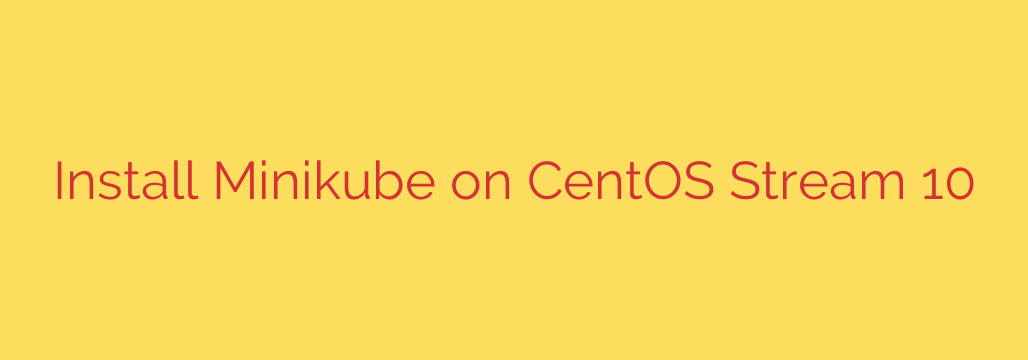
How to Install Minikube on CentOS Stream 10: A Step-by-Step Guide
Developing and testing applications for Kubernetes can be complex, but setting up a local development environment doesn’t have to be. Minikube is a powerful tool that allows you to run a single-node Kubernetes cluster directly on your local machine, making it perfect for developers, students, and anyone looking to learn Kubernetes without the overhead of a full-scale cloud deployment.
This comprehensive guide will walk you through the process of installing Minikube on CentOS Stream 10. We’ll cover everything from system preparation to starting your first local cluster, ensuring you have a smooth and successful setup.
Prerequisites
Before we begin, ensure you have the following:
- A system running CentOS Stream 10.
- Sudo or root access to install software and manage services.
- A stable internet connection to download necessary packages.
- At least 2 CPUs, 2GB of RAM, and 20GB of free disk space for Minikube to run effectively.
Step 1: Update Your System
First, it’s always a best practice to ensure your system’s packages are up to date. This helps prevent potential conflicts and security vulnerabilities. Open your terminal and run the following command:
sudo dnf update -y
Step 2: Install a Virtualization Driver
Minikube requires a hypervisor, or virtualization driver, to create the virtual machine that will host your Kubernetes cluster. For a Linux system like CentOS Stream, the native choice is KVM (Kernel-based Virtual Machine), which offers excellent performance.
Install KVM and related tools:
Run this command to install the necessary packages for KVM and virtualization management.sudo dnf install @virtualization -yStart and Enable the libvirtd Service:
Thelibvirtddaemon manages the virtualization platform. We need to start it and enable it to launch automatically on system boot.sudo systemctl start libvirtd sudo systemctl enable libvirtdAdd Your User to the
libvirtGroup:
To manage virtual machines without needing to usesudofor every command, you must add your user account to thelibvirtgroup. This is a crucial security and convenience step.sudo usermod -aG libvirt $(whoami)Important: You must log out and log back in for this group change to take effect. You can verify your membership with the
groupscommand after logging back in.
Step 3: Install kubectl
The kubectl command-line tool is the primary way you will interact with your Kubernetes cluster. You use it to deploy applications, inspect resources, and manage the cluster’s state.
Download the
kubectlbinary:curl -LO "https://dl.k8s.io/release/$(curl -L -s https://dl.k8s.io/release/stable.txt)/bin/linux/amd64/kubectl"Make the binary executable and move it to your PATH:
This makes thekubectlcommand available system-wide.chmod +x ./kubectl sudo mv ./kubectl /usr/local/bin/kubectlVerify the installation:
Check the version to confirmkubectlis installed correctly.kubectl version --client
Step 4: Install Minikube
With the prerequisites in place, we can now install Minikube itself.
Download the latest Minikube binary:
curl -Lo minikube https://storage.googleapis.com/minikube/releases/latest/minikube-linux-amd64Install the binary:
Use theinstallcommand to move the binary to/usr/local/bin, which also sets the correct permissions.sudo install minikube /usr/local/bin/Verify the Minikube installation:
minikube version
Step 5: Start Your Minikube Cluster
You are now ready to start your local Kubernetes cluster. This command will download the necessary container images and configure a single-node cluster using the KVM driver we installed earlier.
minikube start --driver=kvm2
The process may take a few minutes as it downloads the required components for the first time. Once complete, you will see a success message indicating your cluster is running.
Step 6: Verify and Interact with Your Cluster
Now that your cluster is running, let’s confirm everything is working correctly.
Check Minikube Status:
This command provides a quick overview of the host, Kubernetes components, andkubectlconfiguration.minikube statusUse
kubectlto Check Nodes:
Run akubectlcommand to ensure it can communicate with your new cluster. This command should show a single node with a “Ready” status.kubectl get nodesYou have now successfully deployed a local Kubernetes cluster on CentOS Stream 10!
Essential Minikube Management Commands
Here are a few more useful commands for managing your local environment:
Access the Kubernetes Dashboard: Minikube comes with a built-in web-based dashboard.
minikube dashboardStop the Cluster: To pause the cluster without deleting it, freeing up resources:
minikube stopDelete the Cluster: To completely remove the cluster and all its data:
minikube deleteSSH into the Cluster: For advanced debugging, you can get a shell inside the Minikube virtual machine:
bash
minikube ssh
With Minikube installed, you now have a powerful and flexible environment for building, testing, and learning Kubernetes right from your CentOS Stream machine.
Source: https://infotechys.com/install-minikube-on-centos-stream-10/








